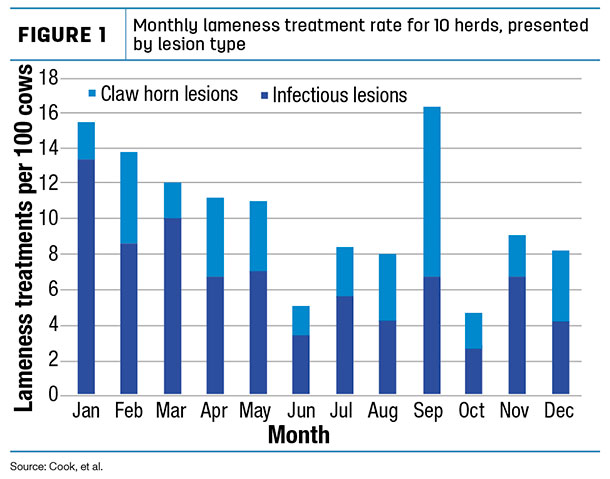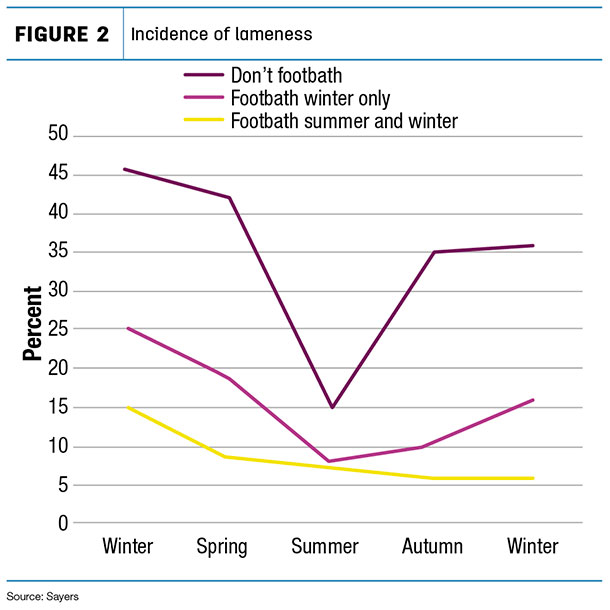Many dairy producers point to freezing winter weather as a reason to reduce or eliminate footbath use. Before accepting this as fact, let’s review winter footbath research to see “if” there is a benefit “and” recommended winter footbath practices, and then determine “but” what is the most economical and effective winter hoof treatment.
The ‘ifs’ – Is there a benefit to winter footbath?
Cook et al. tracked the monthly lameness rate for 10 Wisconsin herds. He found the highest rate of infectious lesion treatment occurs in the months of January through March (Figure 1).

Sayer showed a similar winter spike in lameness incidence. This study further supported winter footbath use by showing winter lameness of:
- 45 percent in herds with no footbath use
- 25 percent in herds with winter footbaths only
- 15 percent incidence in herds using footbaths year-round (Figure 2)

These studies clearly answer the question of “if” winter footbaths are beneficial with a resounding “yes.”
The ‘ands’ – Are there recommended practices for winter footbaths?
“And” what additional management practices are recommended in freezing weather to continue effectively using your footbath in the winter? Here are a few:
-
Spread salt on concrete surfaces near the bath to prevent freezing and a bovine skating rink. Some people recommend moving a portable bath closer to a heated parlor during winter to avoid freezing. However, a properly placed or permanent footbath shouldn’t or can’t be moved without likely negatively affecting cow traffic.
-
Mix treatment products with warm water. This is often a common practice to improve solubility of dry footbath treatment products. This practice can also deter bath-freezing and heat cement surfaces in contact with the bath.
-
Store treatment products in heat. The freezing point of different liquid treatment concentrates varies greatly. Formaldehyde, unless blended with methanol, requires heated storage of mid-50ºF and begins losing efficacy at 45ºF or below. At the other extreme, some liquid product concentrate does not freeze until minus 40ºF.
-
Use a higher step-in/step-out height (8 to 10 inches) for your bath design to avoid splashing solution out. Solution splashing out affects both potential cow pass numbers and freezing concrete surfaces. Many portable poly baths are only 6 inches deep on level surfaces. Avoid filling these baths less than 1 inch from the top to maintain an acceptable treatment depth without excessive treatment loss.
-
Implement hydrated lime and copper sulfate dry footbaths in extreme cold weather. This approach avoids freezing in the bath and surrounding concrete; however, it requires more management to remove surface manure and monitor urine load. Excess urine creates a paste that freezes and prevents the hoof coating of the hydrated lime and copper sulfate powder.
-
Design a bypass footbath treatment lane for better cow traffic. The treatment lane can be easily bypassed during milking if deterioration or freezing of the footbath is observed.
-
Scrape alleys more frequently to avoid irregular, rigid walking surfaces. Clean walkways provide better footing and minimize cracks of the hoof claw. Hoof cracks increase the risk of bruises or abscesses, and allow infectious bacterial contact within the claw. Cleaner, drier environments also allow more treatment reaction time for better bacterial kill.
-
Improve cow comfort.
- Clean bedded, raked freestalls. Cows are more likely to lie down in clean stalls and leave a wet alley.
- Target 100 percent or less stocking density. This improves the opportunity to increase lying time and maximize bunk space to reduce standing time for eating. Shearer and van Amstel state a 120 percent stocking density increases standing time by 15 to 25 percent.
The ‘buts’ – Are winter footbath economics different?
We’ve seen the need for a footbath in winter months and some practices that improve winter footbath management, but is it economical to implement? Shearer and van Amstel point out that even though footbaths are proven effective, they may be inefficient since the entire herd passes through the footbath, though only 15 to 20 percent may need treatment.
In addition, most footbath products report their optimum effective cow passes based on a single milking. Many smaller dairies use the same footbath for two consecutive milkings to approach the reported maximum per bath. These herds may be limited to use of the bath for one milking in the winter, assuming the bath freezes between milkings.
A common 50-gallon footbath costing $25 with a reported maximum of 300 cow passes calculates to:
- 8.33 cents per cow pass for a single milking with a 300-cow herd
- 16.67 cents per cow pass for a single milking with a 150-cow herd
Footbath economics in winter months favor the herd size that maximizes the manufacturer’s cow pass recommendations in a single milking.
Topical treatment
Some dairies, particularly those with less than 150 cows, choose to use topical treatments in winter months. This allows treatment of specific cows rather than the whole herd. While the cost may appear to be less for topical treatment, the success of identifying infectious hoof conditions and consistent treatment application may offset any treatment cost advantage.
Cutler et al. surveyed 109 freestall and 100 tiestall dairies to determine producer awareness of lameness. Total producer awareness of lameness was 9 percent, compared to the researchers’ estimate of 22 percent lameness. This means producers are nearly 2.5 times less likely to make a successful identification. There was a tremendous difference in producer lameness identification between freestalls (1.8 times less likely) versus tiestalls (4.1 times less likely). It is probable that less cow activity and floor-level viewing made identification more difficult in a tiestall setting.
Labor demands are also a tremendous consideration in the success of topical hoof treatment. Many topical treatments require four to eight consecutive days of treatment per individual cow for effective control. This means that topical hoof treatment would be added to the daily milking routine for labor to identify and treat individual cows. Producers should form their own conclusions on the labor impact and success of routine individual cow topical treatments.
In conclusion:
- When asking “if” winter footbaths are needed, the answer is yes. Lameness is most prevalent in the late winter months of January through March but can be reduced by half with winter footbathing.
- “And” a few simple management changes help maintain an effective bath. Care must be taken to avoid frozen, slippery conditions around the bath, and increase pen scraping to reduce irregular hard walking surfaces. Freestall cow comfort and 100 percent stocking density reduces lane manure volume and reduces standing time on wet surfaces.
- “But” producers must consider their herd size for the most economical footbath method and evaluate products for winter efficacy. Multiple milkings per footbath is not possible in freezing weather. Topical treatment appears cost-effective, but poor lameness identification and intensive additional labor for daily topical treatments is a serious concern.
Winter is not an excuse for eliminating hoof health practices. Each producer should review the “ifs,” “ands” and “buts” of their own winter footbath protocols to determine the products and methods that will lead to winter hoof care success. ![]()
References omitted but are available upon request. Click here to email an editor.
Dr. Jim Edwards has a doctorate in ruminant nutrition and is the Hoof-Zink sales and technical specialist for Sirius LLC.
PHOTO: Staff photo.

-
Jim Edwards
- Hoof-Zink Sales and Technical Specialist
- Sirius LLC
- Email Jim Edwards






